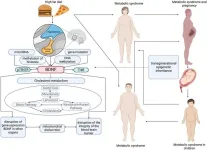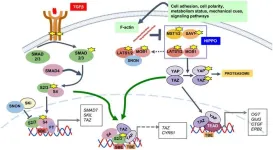(Press-News.org) (Toronto, July 30, 2024) JMIR Publications, a leading publisher in digital health research, announces the launch of JMIR XR and Spatial Computing, a cutting-edge journal dedicated to exploring the transformative potential of extended reality (XR) and spatial computing technologies in clinical practice.
This new journal arrives at a pivotal moment when recent advancements in artificial intelligence (AI), graphical processing, display technology, and network connectivity are propelling XR and spatial computing from the realm of possibility into the realm of practical application in health care.
With over a decade of experience in navigating the XR and spatial computing landscape, JMIR Publications adopts a stance of informed optimism, acknowledging both the potential and the challenges of integrating these technologies into health care. The journal aims to foster candid discussions, promote rigorous research, and explore how these technologies can improve diagnostic precision, treatment efficacy, access to care, and ultimately, patient outcomes.
"XR and spatial computing are poised to revolutionize health care, but their successful integration requires thoughtful consideration and collaboration," said Dr Lars Riedemann, editor-in-chief of JMIR XR and Spatial Computing. "Our new journal provides a platform for researchers, clinicians, and industry innovators to share their insights, showcase their work, and shape the future of this exciting field."
JMIR XR and Spatial Computing welcomes submissions on a wide range of topics, including but not limited to:
Applications of XR and spatial computing in various medical specialties
Ethical considerations and challenges in the adoption of immersive technologies
Research on the impact of XR and spatial computing on patient outcomes and health care efficiency
Development of innovative solutions to address accessibility and equity issues
Exploration of academic-industrial collaborations and open-source projects
The journal actively encourages contributions from diverse sources, including academic researchers, industry partners, independent developers, and open-source communities. By fostering a collaborative environment, JMIR XR and Spatial Computing aims to accelerate the development and adoption of responsible, effective, and accessible XR and spatial computing solutions in health care.
To gain further insights into the vision and objectives of this groundbreaking journal, we invite you to read the full editorial “Discovering and Creating the Leading Edge of Extended Reality and Spatial Computing: A Message From the Editor-in-Chief” penned by Dr Riedemann, available on the JMIR XR and Spatial Computing website.
About JMIR Publications:
JMIR Publications, celebrating its 25th anniversary in 2024, is a leading open access digital health research publisher. As a pioneer in open access publishing, JMIR Publications is committed to driving innovation in scholarly communications, advancing digital health research, and promoting open science principles. Our portfolio features 35 open access, peer-reviewed journals dedicated to the dissemination of high-quality research in the field of digital health, including the Journal of Medical Internet Research, as well as cross-disciplinary journals such as JMIR Research Protocols and the new title JMIR XR & Spatial Computing.
END
JMIR Publications launches new peer-reviewed journal: JMIR XR and spatial computing
2024-07-30
ELSE PRESS RELEASES FROM THIS DATE:
(Epi)genetic aspects of metabolic syndrome pathogenesis in relation to brain-derived neurotrophic factor expression
2024-07-30
Metabolic syndrome (MetS) is a multifaceted disorder that impacts approximately 20–25% of the global population. This syndrome encompasses a range of conditions, including obesity, type 2 diabetes mellitus, hyperinsulinemia, insulin resistance (IR), hypercholesterolemia, nonalcoholic fatty liver disease, nonalcoholic steatohepatitis, and systemic metabolic inflammation. These conditions collectively lead to severe diseases and increased premature mortality. The hypothalamus, a critical brain structure regulating ...
Controlled Release Society inducts SwRI’s Dr. James Oxley into College of Fellows
2024-07-30
SAN ANTONIO — July 30, 2024 — Dr. James Oxley, an Institute scientist at Southwest Research Institute’s Chemistry and Chemical Engineering Division, has been named a Fellow by the Controlled Release Society. Recognized for excellence and innovation in delivery science, Oxley is an expert in microencapsulation, nanoencapsulation and other controlled-release technologies used in energy, food, pharmaceutical, cosmetic and consumer product applications.
“I’m honored and humbled by this recognition,” said Oxley, who began his Institute career in 2004. “Encapsulation research ...
Arthritis drugs may relieve long COVID lung symptoms
2024-07-30
University of Virginia School of Medicine researchers have identified a potential treatment for the respiratory symptoms of long COVID after discovering an unknown cause of the condition inside the lungs.
The UVA researchers, led by Jie Sun, PhD, found that COVID-19 infection can cause sweeping changes in immune cells inside the lung tissues, promoting scarring and driving ongoing inflammation even after the initial infection has passed. This ongoing inflammation, they believe, drives the lasting respiratory symptoms, such as cough and difficulty breathing, associated with long COVID.
The new research from Sun and ...
New type of “antibiotic” generated from the long pepper recommended
2024-07-30
BEER-SHEVA, Israel, July 30, 2024 – Antibiotic resistant bacterial pathogens are on the rise, while fewer antibiotics are being developed. Prof. Ariel Kushmaro and his local and international colleagues tackled the need by focusing on the long pepper. Known in traditional medicine for its treatment of a variety of illnesses, the team created a derivative that disrupts bacterial chemical communication.
Their findings were just published in Biofilm (https://doi.org/10.1016/j.bioflm.2024.100215).
Many plants' secondary metabolites are essential ...
ACE-ing protein detection in single cells
2024-07-30
By Benjamin Boettner
(BOSTON) — Since the 1950s, researchers have used a famous method invented by Wallace Coulter known as “flow cytometry” to characterize different types of immune cells in research studies and in blood samples from human individuals. This has enabled a much deeper understanding of immune cell development as well as new ways to assess human health and diagnose various blood cancers. Later, flow cytometry was applied also to other cell types.
In traditional flow cytometry, cell surface and intracellular proteins are detected with antibody molecules that are linked to fluorescent probes. However, while providing single-cell ...
Study finds police misconduct ‘hotspots’ across Florida
2024-07-30
Not all police misconduct is the same. Misconduct can range from offenses like homicide and sexual assault to seemingly minor infractions such as accepting free coffee from the public. Exactly what qualifies as police misconduct varies locally, and the response to this behavior is typically handled internally by law enforcement.
The absence of a commonly accepted framework to assess and interpret police misconduct remains a complex and contentious issue. Moreover, progress in researching this area is hindered by the limited ...
Engineered microbes repel mosquitoes
2024-07-30
Genetically engineered human skin bacteria can make mice less attractive to mosquitoes for 11 days. Mosquitoes transmit a host of deadly diseases, including malaria, West Nile, dengue, yellow fever, and Zika. Female mosquitoes on the hunt for a blood meal tune into scents released by skin microbes that live on their targets. Omar Akbari and colleagues engineered versions of the common human skin commensals Staphylococcus epidermidis and Corynebacterium amycolatum to produce much less of a form of lactic acid known to attract mosquitoes. The authors tested the microbes alone and found the engineered version of S. epidermidis attracted about half as ...
TGF-β and HIPPO signaling pathways interplay in distinct hepatic contexts
2024-07-30
The liver's ability to communicate with other organs is crucial for maintaining homeostasis, particularly through signaling pathways. During liver regeneration, communication with organs such as the brain, pancreas, intestine, and heart is vital, mediated by chemical messengers like hormones, cytokines, and growth factors. Among these signals, the TGF-β and HIPPO pathways are critical, functioning as tumor suppressors and regulating liver development and regeneration. The review focuses on these pathways' interplay in maintaining liver homeostasis, facilitating regeneration, and contributing to diseases like hepatitis, fibrosis, ...
Bacteria and keloids
2024-07-30
A study explores the microbiome of keloids, which are treatment-resistant raised scars. Some wounds heal completely; some wounds leave a scar; and some wounds leave a noticeable raised and growing bump larger than the original wound called a keloid. These keloids can itch and cause psychological distress. Keloids are caused by hyperproliferation of cells called fibroblasts that produce collagen. Previous research had suggested that microbiota might be one of many factors influencing fibroblast production. Rui Chen, Tomasz Maj and colleagues looked for bacteria in clinical samples of keloid tissue and found higher concentrations ...
Diet and supplements in cancer prevention
2024-07-30
Cancer is a complex, multifactorial disease with a substantial global burden. Recent years have seen a surge in research focusing on preventive measures, particularly through diet and supplements. The role of nutrition in cancer incidence and prevention is widely recognized, though the specifics of these relationships remain under investigation. This review expands on the findings of Anandu Chandra Khanashyam et al., exploring the nuanced links between diet, supplements, and cancer prevention.
The significance of diet and supplements in cancer prevention is well-documented, with nutrition ...







